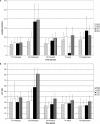Metabolic effects of a late hypotensive insult combined with reduced intracranial compliance following traumatic brain injury in the rat
- PMID: 20977314
- PMCID: PMC2971478
- DOI: 10.3109/03009734.2010.503906
Metabolic effects of a late hypotensive insult combined with reduced intracranial compliance following traumatic brain injury in the rat
Abstract
Introduction: Traumatic brain injury makes the brain vulnerable to secondary insults. Post-traumatic alterations in intracranial dynamics, such as reduced intracranial compliance (IC), are thought to further potentiate the effects of secondary insults. Reduced IC combined with intracranial volume insults leads to metabolic disturbances in a rat model. The aim of the present study was to discern whether a post-traumatic hypotensive insult in combination with reduced IC caused more pronounced secondary metabolic disturbances in the injured rat brain.
Materials and methods: Rats were randomly assigned to four groups (n = 8/group): 1) trauma with hypotension; 2) trauma and reduced IC with hypotension; 3) sham injury with hypotension; and 4) sham injury and reduced IC with hypotension. A weight drop model of cortical contusion trauma was used. IC was reduced by gluing rubber film layers on the inside of bilateral bone flaps before replacement. Microdialysis probes were placed in the perimeter of the trauma zone. Hypotension was induced 2 h after trauma. Extracellular (EC) levels of lactate, pyruvate, hypoxanthine, and glycerol were analyzed.
Results: The trauma resulted in a significant increase in EC dialysate levels of lactate, lactate/pyruvate ratio, hypoxanthine, and glycerol. A slight secondary increase in lactate was noted for all groups but group 2 during hypotension, otherwise no late effects were seen. There were no effects of reduced IC.
Discussion: In conclusion, reduced IC did not increase the metabolic disturbances caused by the post-traumatic hypotensive insult. The results suggest that a mild to moderate hypotensive insult after initial post-traumatic resuscitation may be tolerated better than an early insult before resuscitation.
Figures





Similar articles
-
Low intracranial compliance increases the impact of intracranial volume insults to the traumatized brain: a microdialysis study in a traumatic brain injury rodent model.Neurosurgery. 2006 Aug;59(2):367-73; discussion 367-73. doi: 10.1227/01.NEU.0000222648.61065.38. Neurosurgery. 2006. PMID: 16883177
-
Posttraumatic brain vulnerability to hypoxia-hypotension: the importance of the delay between brain trauma and secondary insult.Intensive Care Med. 2008 Mar;34(3):551-60. doi: 10.1007/s00134-007-0863-0. Epub 2007 Oct 16. Intensive Care Med. 2008. PMID: 17938889
-
The frontal lobe and thalamus have different sensitivities to hypoxia-hypotension after traumatic brain injury: a microdialysis study in rats.J Neurotrauma. 2012 Dec 10;29(18):2782-90. doi: 10.1089/neu.2012.2381. Epub 2012 Sep 25. J Neurotrauma. 2012. PMID: 22860603
-
Resuscitation from severe brain trauma.Crit Care Med. 1996 Feb;24(2 Suppl):S48-56. Crit Care Med. 1996. PMID: 8608706 Review.
-
Blast-induced brain injury and posttraumatic hypotension and hypoxemia.J Neurotrauma. 2009 Jun;26(6):877-87. doi: 10.1089/neu.2007.0439. J Neurotrauma. 2009. PMID: 18447627 Review.
References
-
- Becker DP, Miller JD, Ward JD, Greenberg RP, Youhg HF, Sakalas R. The outcome from severe head injury with early diagnosis and intensive management. J Neurosurg. 1977;47:491–502. - PubMed
-
- Bowers SA, Marshall LF. Outcome in 200 consecutive cases of severe head injury treated in San Diego County: a prospective analysis. Neurosurgery. 1980;6:237–42. - PubMed
-
- Nordstrom CH, Sundbarg G, Messeter K, Schalén W. Severe traumatic brain lesions in Sweden. Part 2: Impact of aggressive neurosurgical intensive care. Brain Inj. 1989;3:267–81. - PubMed
Publication types
MeSH terms
Substances
LinkOut - more resources
Full Text Sources
Medical
